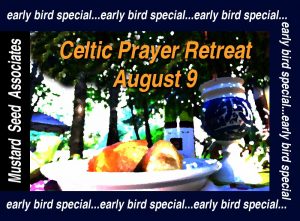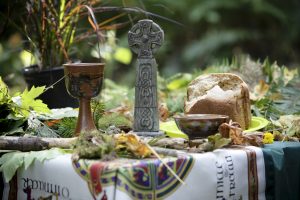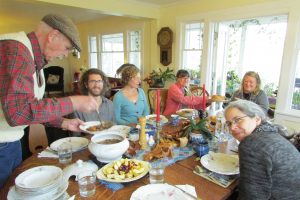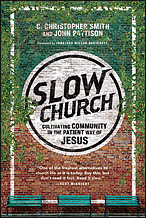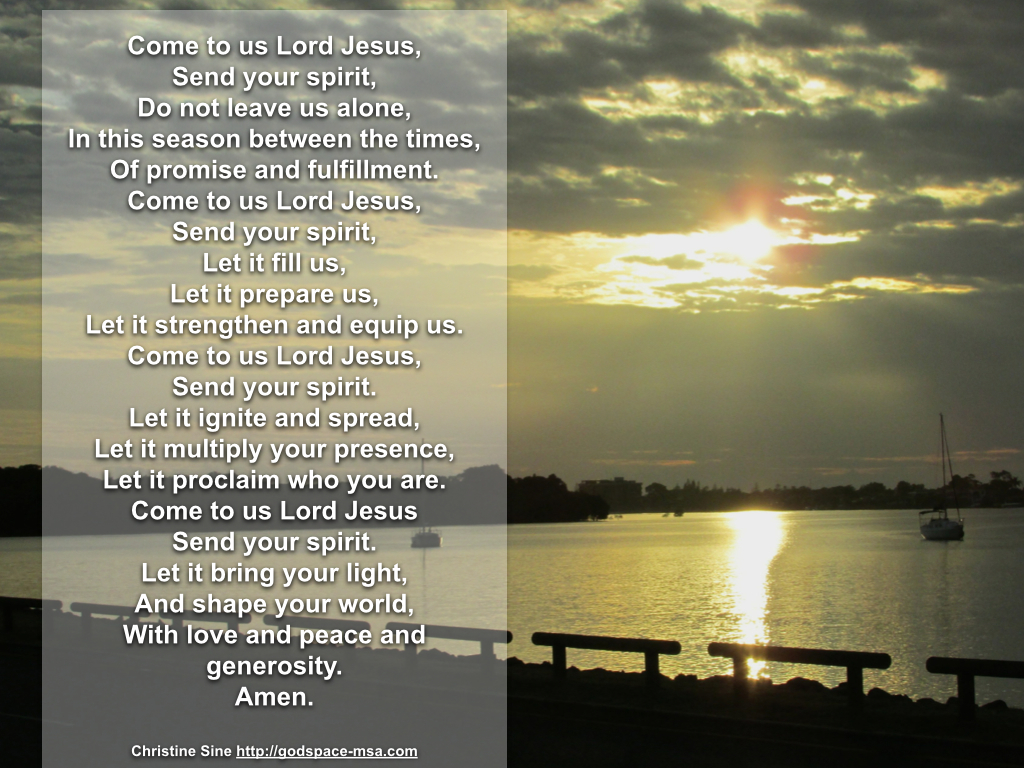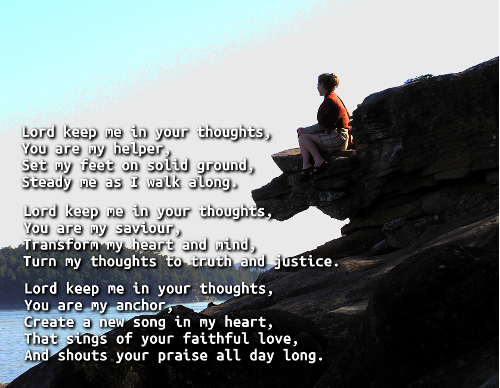We are so excited about our retreat on Camano this year that we wanted to make it as easy as possible for everyone to attend. We have just posted our early bird special rates.
The theme for this year is Brigid and the Hospitality of God. This is yet another aspect of our focus on Hospitality and the Kingdom of God, our theme here at Godspace for the next few months.
Come join us on Camano Island WA for this wonderful weekend. More details here
- share a time of guided retreat and reflection beginning at 9am Saturday morning with coffee and snacks. enjoy the prayer trails and prayerful activities during the afternoon celebrate with a BBQ potluck dinner that night.
- Both kids and students will have a program designed especially for their time at the Retreat.
- We also invite you to camp with us Friday and Saturday nights, and to share morning and evening prayers and a time of reflective worship Sunday morning.
- Find out about the different options here
Jesus, who welcomes all who come to him, shows us the pattern that is repeated in Eastern hospitality and in the Celtic way of life. The idea that the one I welcome is the “Christ in the stranger’s guise” calls me to recognize the image of God in all persons and the presence of God in all creation. This understanding changes my attitude toward every person. I open my heart and seek the good, rather than raise my walls of defense and look with suspicion. Celtic spirituality teaches not only hospitality to the stranger but welcome to the poor and the marginalized.
At the retreat we will use the life of Brigid, one of my favourite Celtic saints, to guide us. She became abbess at the monastery of Kildaire where, under her leadership, a thousand meals were reportedly served each day. I always use Brigid’s Feast as a grace for our retreats. This year our liturgies, songs and scripture readings will also revolve around her love for the poor and her generous hospitality.
Each year our Saturday meals are potlucks with delicious salads and desserts contributed by attendees. This year we would like to start collecting some of these wonderful recipes to help us get to know each other better. So if you plan to come, write out your recipe with your name and contact information send it to us so that we can make these available for other attendees. This year’s retreat will be a grand summer celebration of welcome and feasting. We hope you can join us.
your kindness melts my hard, cold soul.
your beauty fills my dull, sad eyes.
Yesterday there was another school shooting. This time right in my backyard. In fact I had been at Seattle Pacific University walking across the area where the shooting occurred, just a couple of hours before. One person died, three others injured, one still critical. It is probable that more would have been killed if were not for a student, John Meis, volunteer security guard sprayed the gunman with pepper spray and tackled him, with other students then jumping on top.
The horror of the senseless loss of life, the pain and agony of family, the trauma to those around hits my heart with great heaviness. When will this gun violence stop I wonder? When will we realize that there need to be restrictions on sales of guns?
Guns do not make a nation or a family safer. Quite the contrary according to this article published in the American Journal of Medicine last year. The U.S. has more guns and more gun deaths than any other country in the world.
One of my biggest struggles with living in the U.S. has been the acceptance of violence as a way of life – even amongst Christians. And maybe we will not see a change in the gun laws here until Christians change their attitudes. We are not called to violence we are called to peace. The images of God’s kingdom are of a peaceable kingdom in which there will be no death or violence or war.
I think it is time that we not only embraced this imagery but practiced it. Can you imagine how different our world would look today if followers of Jesus all laid down their guns and looked for peaceful ways to resolve conflict and violence. Until we are willing to do that I don’t think that we will see any change in the violence of our society or in the attitude towards guns.
What do you think?
As you know I am getting ready for the upcoming blog focus on Hospitality and the Kingdom of God. Have been doing lots of reading, thinking and praying about it.
When I decided on this topic I had no idea how impacting it would be on my own life. It is helping me to rethink the focus of my faith and how I practice it.
Communion not conversion. Eating together, sharing life and fellowship together this is the place where we are inspired by Christ and fed by him to go out and do his work in the world.
So many today find church boring and irrelevant, but eating is relevant for all of us. And when done properly with us all sitting down together, relaxed, laughing, sharing stories, it is the richest experience of Christ and Christ’s family we can ever have.
This morning I found my thoughts focusing once again on the two occasions we read about Jesus eating with his disciples after his resurrection. Christ comes in the stranger on the Emmaus road. His true nature is recognized only when he breaks bread together with his fellow travellers. (Luke 24:30, 31) We also find him by the sea of Galilee, preparing breakfast for his closest friends. Here he is recognized when the nets almost break with the abundance of God’s provision. And then they break bread together, sharing their lives with the living Christ. (John 21:13). Even when Jesus appears to the disciples together it is at the dinner table, and he proves who he is by eating with them (Luke 24:42).
How much, I wonder, does our fast food, TV dinner lifestyle disconnect us from Christ and God’s family? Eating alone, isolated from our human families, unaware of where our food comes from and of those who have produced it, strips us of both our humanity and our divinity. To be made in the image of God means to eat together with friends and strangers alike. It means to make the excluded feel included, as Jesus did by sitting down with the tax collector. It means to see abundance when others see scarcity, as is demonstrated by the feeding of the 5,000. And it means to be caught up in a foretaste of the kingdom banquet feast, as the first disciples were when they ate the last supper together.
We need to rediscover the joy of eating together – not just of sitting down at table, but the joy of growing and preparing food together. Perhaps its time we all joined the Slow Food movement, a global, grassroots organization linking the pleasure of good food with a commitment to their community and the environment.
Chris Smith and John Pattison authors of Slow Church will be with us Monday night. In this wonderful and timely book they remind us that:
Slow Food and the other Slow movements hold important lessons for the American church. They compel us to ask ourselves tough questions about the ground our faith communities have ceded to the cult of speed. And they invite all of us—clergy, theologians and laypeople—to start exploring and experimenting with the possibilities of Slow Church. Not as another growth strategy, but as a way of re-imagining what it means to be communities of believers gathered and rooted in particular places at a particular time.
I think that they are right. We need to learn that at the centre of our faith is the communion table, a place of rich fellowship and shared life, an experience that cannot be hurried if we truly value our faith and the faith communities of which we are a part.
What do you think?
The prayer above is one of the prayer cards that we produced last year. I have it set up on an easel on my desk and find my eyes and my thoughts continually moving to it during the day. It revolves in my mind, refreshing and renewing me, focusing me beyond myself to God and to the world in which I live.
I am awed by the creativity that flows from God through all of us. It is part of who we are and who God calls us to be. Allow God to work through you to be creative today. May it refresh and restore you too.
We are living between the days of Jesus’s ascension and Pentecost when the gift of the Holy Spirit was received. It must have been a challenging time, hoping yet I am sure also doubting. Could the disciples really believe the amazing things that had happened in the previous 40 days. Was it all an illusion? Had Jesus really been resurrected? And what happens now? Was he still with them?
I am sure that his followers, all 120 of them gathered for support and comfort. I can imagine them sharing their doubts and their fears, praying for strength and courage to go out and do the things Jesus asked of them. I can imagine them wondering if it was all a dream, and praying for faith, for equipping and for the fulfillment of God’s promises.
Not much difference from where we are at today. God’s people are always gathering, waiting for the spirit to fall in fresh ways, waiting and hoping for manifestations of God’s spirit that will equip and strengthen us to go out into the world and be spread as light and love. And like the disciples we wait hopefully but unsure. We wait expectantly, but fearfully. Can we really accomplish what Jesus asks of us?
We live at a time when numbers in churches are declining. We are concerned, fearful, wondering if God’s presence in the world is declining. Yet there are still 1 billion people who call themselves Christians. Imagine if the spirit fell on all of us igniting us with the same fire that filled those early disciples. This world would indeed be transformed and God’s new world of wholeness and abundance would indeed come in its fulness.
Lord Jesus Christ
You have ascended into heaven.
Do not leave us alone.
Do not leave us comfortless,
In this season between the times
Of promise and fulfillment.
Come to us Lord Jesus
Send your spirit.
Let it fill us.
Let it strengthen and equip us.
Come to us Lord Jesus,
Send your spirit.
Let it prepare us,
Let it proclaim who you are.
Come to us Lord Jesus
Set your spirit.
Let it ignite and spread,
Let it multiply your presence,
Let it shape your world,
with love and peace and generosity.
Amen.
As an Amazon Associate, I receive a small amount for purchases made through appropriate links.
Thank you for supporting Godspace in this way.
When referencing or quoting Godspace Light, please be sure to include the Author (Christine Sine unless otherwise noted), the Title of the article or resource, the Source link where appropriate, and ©Godspacelight.com. Thank you!

